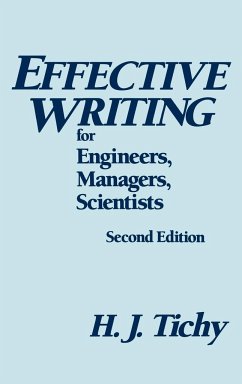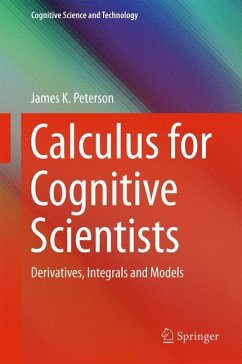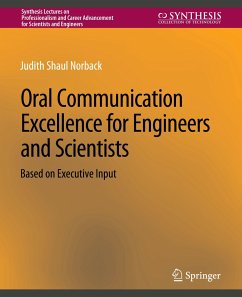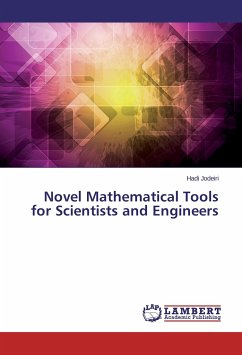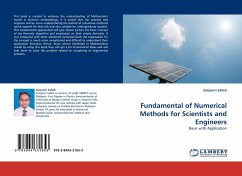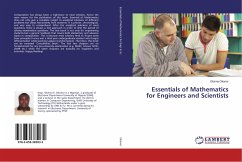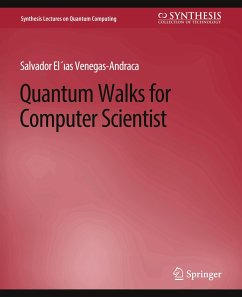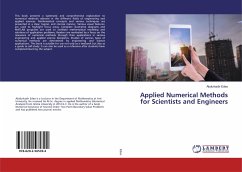
Calculus for Scientists and Engineers, m. 1 Beilage, m. 1 Online-Zugang; .
Early Transcendentals, Single Variable Plus MyMathLab -- Access Card Package. Mit Online-Zugang
Versandkostenfrei!
Liefertermin unbestimmt
103,99 €
inkl. MwSt.
For a two-semester or three-quarter calculus course covering single variable calculus for mathematics, engineering, and science majors.
Briggs/Cochran is the most successful new calculus series published in the last two decades. The authorsÆ decades of teaching experience resulted in a text that reflects how students generally use a textbookùi.e., they start in the exercises and refer back to the narrative for help as needed. The text therefore builds from a foundation of meticulously crafted exercise sets, then draws students into the narrative through writing that reflects the voice of the instructor, examples that are stepped out and thoughtfully annotated, and figures that are designed to teach rather than simply supplement the narrative. The authors appeal to studentsÆ geometric intuition to introduce fundamental concepts, laying a foundation for the rigorous development that follows.
To further support student learning, the MyMathLab course features an eBook with 700 Interactive Figures that can be manipulated to shed light on key concepts. In addition, the InstructorÆs Resource Guide and Test Bank features quizzes, test items, lecture support, guided projects, and more.
*This book covers chapters single variable topics (chapters 1û10) of Calculus for Scientists and Engineers: Early Transcendentals, which is an expanded version of Calculus: Early Transcendentals by the same authors.
Product Description
ALERT: Before you purchase, check with your instructor or review your course syllabus to ensure that you select the correct ISBN. Several versions of Pearson's MyLab & Mastering products exist for each title, including customized versions for individual schools, and registrations are not transferable. In addition, you may need a CourseID, provided by your instructor, to register for and use Pearson's MyLab & Mastering products.
Packages
Access codes for Pearson's MyLab & Mastering products may not be included when purchasing or renting from companies other than Pearson; check with the seller before completing your purchase.
Used or rental books
If you rent or purchase a used book with an access code, the access code may have been redeemed previously and you may have to purchase a new access code.
Access codes
Access codes that are purchased from sellers other than Pearson carry a higher risk of being either the wrong ISBN or a previously redeemed code. Check with the seller prior to purchase.
--
Drawing on their decades of teaching experience, William Briggs and Lyle Cochran have created a calculus text that carries the teacher’s voice beyond the classroom. That voice—evident in the narrative, the figures, and the questions interspersed in the narrative—is a master teacher leading readers to deeper levels of understanding. The authors appeal to readers’ geometric intuition to introduce fundamental concepts and lay the foundation for the more rigorous development that follows. Comprehensive exercise sets have received praise for their creativity, quality, and scope. This book covers chapters single variable topics (chapters 1—10) of Calculus for Scientists and Engineers: Early Transcendentals, which is an expanded version of Calculus: Early Transcendentals by the same authors.
0321844548 / 9780321844545 Calculus for Scientists and Engineers: Early Transcendentals, Single Variable plus MyMathLab Student Access Kit
Package consists of
0321431308 / 9780321431301 MyMathLab/MyStatLab -- Glue-in Access Card
0321654064 / 9780321654069 MyMathLab Inside Star Sticker
0321785509 / 9780321785503 Calculus for Scientists and Engineers: Early Transcendentals, Single Variable
Features + Benefits
Topics are introduced through concrete examples, geometric arguments, applications, and analogies rather than through abstract arguments. The authors appeal to students’ intuition and geometric instincts to make calculus natural and believable.
Figures are designed to help today’s visually oriented learners. They are conceived to convey important ideas and facilitate learning, annotated to lead students through the key ideas, and rendered using the latest software for unmatched clarity and precision.
Comprehensive exercise sets provide for a variety of student needs and are consistently structured and labeled to facilitate the creation of homework assignments by inspection.
Review Questions check that students have a general conceptual understanding of the essential ideas from the section.
Basic Skills exercises are linked to examples in the section so students get off to a good start with homework.
Further Explorations exercises extend students’ abilities beyond the basics.
Applications present practical and novel applications and models that use the ideas presented in the section.
Additional Exercises challenge students to stretch their understanding by working through abstract exercises and proofs.
Examples are plentiful and stepped out in detail. Within examples, each step is annotated to help students understand what took place in that step.
Quick Check exercises punctuate the narrative at key points to test understanding of basic ideas and encourage students to read with pencil in hand.
The MyMathLab course for the text features the following:
More than 7,000 assignable exercises provide you with the options you need to meet the needs of students. Most exercises can be algorithmically regenerated for unlimited practice.
Learning aids include guided exercises, additional examples, and tutorial videos. You control how much help your students can get and when.
700 Interactive Figures in the eBook can be manipulated to shed light on key concepts. The figures are also ideal for in-class demonstrations.
Interactive Figure Exercises provide a way for you make the most of the Interactive Figures by including them in homework assignments.
A “Getting Ready for Calculus” chapter, with built-in diagnostic tests, identifies each student’s gaps in skills and provides individual remediation directly to those skills that are lacking.
Ready to Go Courses designed by experienced instructors minimize the start-up time for new MyMathLab users.
Guided Projects, available for each chapter, require students to carry out extended calculations (e.g., finding the arc length of an ellipse), derive physical models (e.g., Kepler’s Laws), or explore related topics (e.g., numerical integration). The “guided” nature of the projects provides scaffolding to help students tackle these more involved problems.
The Instructor’s Resource Guide and Test Bank provides a wealth of instructional resources including Guided Projects, Lecture Support Notes with Key Concepts, Quick Quizzes for each section in the text, Chapter Reviews, Chapter Test Banks, Tips and Help for Interactive Figures, and Student Study Cards.
This book is an expanded version of Calculus: Early Transcendentals by the same authors. It contains an entire chapter devoted to differential equations and additional sections on other topics (Newton’s method, surface area of solids of revolution, and hyperbolic functions). Most sections also contain additional exercises, many of them mid-level skills exercises.
1. Functions
1.1 Review of functions
1.2 Representing functions
1.3 Inverse, exponential, and logarithmic functions
1.4 Trigonometric functions and their inverses
2. Limits
2.1 The idea of limits
2.2 Definitions of limits
2.3 Techniques for computing limits
2.4 Infinite limits
2.5 Limits at infinity
2.6 Continuity
2.7 Precise definitions of limits
3. Derivatives
3.1 Introducing the derivative
3.2 Rules of differentiation
3.3 The product and quotient rules
3.4 Derivatives of trigonometric functions
3.5 Derivatives as rates of change
3.6 The Chain Rule
3.7 Implicit differentiation
3.8 Derivatives of logarithmic and exponential functions
3.9 Derivatives of inverse trigonometric functions
3.10 Related rates
4. Applications of the Derivative
4.1 Maxima and minima
4.2 What derivatives tell us
4.3 Graphing functions
4.4 Optimization problems
4.5 Linear approximation and differentials
4.6 Mean Value Theorem
4.7 L'Hôpital's Rule
4.8 Newton's Method
4.9 Antiderivatives
5. Integration
5.1 Approximating areas under curves
5.2 Definite integrals
5.3 Fundamental Theorem of Calculus
5.4 Working with integrals
5.5 Substitution rule
6. Applications of Integration
6.1 Velocity and net change
6.2 Regions between curves
6.3 Volume by slicing
6.4 Volume by shells
6.5 Length of curves
6.6 Surface area
6.7 Physical applications
6.8 Logarithmic and exponential functions revisited
6.9 Exponential models
6.10 Hyperbolic functions
7. Integration Techniques
7.1 Integration Strategies
7.2 Integration by parts
7.3 Trigonometric integrals
7.4 Trigonometric substitutions
7.5 Partial fractions
7.6 Other integration strategies
7.7 Numerical integration
7.8 Improper integrals
8. Differential Equations
8.1 Basic ideas
8.2 Direction fields and Euler's method
8.3 Separable differential equations
8.4 Special first-order differential equations
8.5 Modeling with differential equations
9. Sequences and Infinite Series
9.1 An overview
9.2 Sequences
9.3 Infinite series
9.4 The Divergence and Integral Tests
9.5 The Ratio, Root, and Comparison Tests
9.6 Alternating series
10. Power Series
10.1 Approximating functions with polynomials
10.2 Properties of Power series
10.3 Taylor series
10.4 Working with Taylor series
11. Parametric and Polar Curves
11.1 Parametric equations
11.2 Polar coordinates
11.3 Calculus in polar coordinates
11.4 Conic sections
Briggs/Cochran is the most successful new calculus series published in the last two decades. The authorsÆ decades of teaching experience resulted in a text that reflects how students generally use a textbookùi.e., they start in the exercises and refer back to the narrative for help as needed. The text therefore builds from a foundation of meticulously crafted exercise sets, then draws students into the narrative through writing that reflects the voice of the instructor, examples that are stepped out and thoughtfully annotated, and figures that are designed to teach rather than simply supplement the narrative. The authors appeal to studentsÆ geometric intuition to introduce fundamental concepts, laying a foundation for the rigorous development that follows.
To further support student learning, the MyMathLab course features an eBook with 700 Interactive Figures that can be manipulated to shed light on key concepts. In addition, the InstructorÆs Resource Guide and Test Bank features quizzes, test items, lecture support, guided projects, and more.
*This book covers chapters single variable topics (chapters 1û10) of Calculus for Scientists and Engineers: Early Transcendentals, which is an expanded version of Calculus: Early Transcendentals by the same authors.
Product Description
ALERT: Before you purchase, check with your instructor or review your course syllabus to ensure that you select the correct ISBN. Several versions of Pearson's MyLab & Mastering products exist for each title, including customized versions for individual schools, and registrations are not transferable. In addition, you may need a CourseID, provided by your instructor, to register for and use Pearson's MyLab & Mastering products.
Packages
Access codes for Pearson's MyLab & Mastering products may not be included when purchasing or renting from companies other than Pearson; check with the seller before completing your purchase.
Used or rental books
If you rent or purchase a used book with an access code, the access code may have been redeemed previously and you may have to purchase a new access code.
Access codes
Access codes that are purchased from sellers other than Pearson carry a higher risk of being either the wrong ISBN or a previously redeemed code. Check with the seller prior to purchase.
--
Drawing on their decades of teaching experience, William Briggs and Lyle Cochran have created a calculus text that carries the teacher’s voice beyond the classroom. That voice—evident in the narrative, the figures, and the questions interspersed in the narrative—is a master teacher leading readers to deeper levels of understanding. The authors appeal to readers’ geometric intuition to introduce fundamental concepts and lay the foundation for the more rigorous development that follows. Comprehensive exercise sets have received praise for their creativity, quality, and scope. This book covers chapters single variable topics (chapters 1—10) of Calculus for Scientists and Engineers: Early Transcendentals, which is an expanded version of Calculus: Early Transcendentals by the same authors.
0321844548 / 9780321844545 Calculus for Scientists and Engineers: Early Transcendentals, Single Variable plus MyMathLab Student Access Kit
Package consists of
0321431308 / 9780321431301 MyMathLab/MyStatLab -- Glue-in Access Card
0321654064 / 9780321654069 MyMathLab Inside Star Sticker
0321785509 / 9780321785503 Calculus for Scientists and Engineers: Early Transcendentals, Single Variable
Features + Benefits
Topics are introduced through concrete examples, geometric arguments, applications, and analogies rather than through abstract arguments. The authors appeal to students’ intuition and geometric instincts to make calculus natural and believable.
Figures are designed to help today’s visually oriented learners. They are conceived to convey important ideas and facilitate learning, annotated to lead students through the key ideas, and rendered using the latest software for unmatched clarity and precision.
Comprehensive exercise sets provide for a variety of student needs and are consistently structured and labeled to facilitate the creation of homework assignments by inspection.
Review Questions check that students have a general conceptual understanding of the essential ideas from the section.
Basic Skills exercises are linked to examples in the section so students get off to a good start with homework.
Further Explorations exercises extend students’ abilities beyond the basics.
Applications present practical and novel applications and models that use the ideas presented in the section.
Additional Exercises challenge students to stretch their understanding by working through abstract exercises and proofs.
Examples are plentiful and stepped out in detail. Within examples, each step is annotated to help students understand what took place in that step.
Quick Check exercises punctuate the narrative at key points to test understanding of basic ideas and encourage students to read with pencil in hand.
The MyMathLab course for the text features the following:
More than 7,000 assignable exercises provide you with the options you need to meet the needs of students. Most exercises can be algorithmically regenerated for unlimited practice.
Learning aids include guided exercises, additional examples, and tutorial videos. You control how much help your students can get and when.
700 Interactive Figures in the eBook can be manipulated to shed light on key concepts. The figures are also ideal for in-class demonstrations.
Interactive Figure Exercises provide a way for you make the most of the Interactive Figures by including them in homework assignments.
A “Getting Ready for Calculus” chapter, with built-in diagnostic tests, identifies each student’s gaps in skills and provides individual remediation directly to those skills that are lacking.
Ready to Go Courses designed by experienced instructors minimize the start-up time for new MyMathLab users.
Guided Projects, available for each chapter, require students to carry out extended calculations (e.g., finding the arc length of an ellipse), derive physical models (e.g., Kepler’s Laws), or explore related topics (e.g., numerical integration). The “guided” nature of the projects provides scaffolding to help students tackle these more involved problems.
The Instructor’s Resource Guide and Test Bank provides a wealth of instructional resources including Guided Projects, Lecture Support Notes with Key Concepts, Quick Quizzes for each section in the text, Chapter Reviews, Chapter Test Banks, Tips and Help for Interactive Figures, and Student Study Cards.
This book is an expanded version of Calculus: Early Transcendentals by the same authors. It contains an entire chapter devoted to differential equations and additional sections on other topics (Newton’s method, surface area of solids of revolution, and hyperbolic functions). Most sections also contain additional exercises, many of them mid-level skills exercises.
1. Functions
1.1 Review of functions
1.2 Representing functions
1.3 Inverse, exponential, and logarithmic functions
1.4 Trigonometric functions and their inverses
2. Limits
2.1 The idea of limits
2.2 Definitions of limits
2.3 Techniques for computing limits
2.4 Infinite limits
2.5 Limits at infinity
2.6 Continuity
2.7 Precise definitions of limits
3. Derivatives
3.1 Introducing the derivative
3.2 Rules of differentiation
3.3 The product and quotient rules
3.4 Derivatives of trigonometric functions
3.5 Derivatives as rates of change
3.6 The Chain Rule
3.7 Implicit differentiation
3.8 Derivatives of logarithmic and exponential functions
3.9 Derivatives of inverse trigonometric functions
3.10 Related rates
4. Applications of the Derivative
4.1 Maxima and minima
4.2 What derivatives tell us
4.3 Graphing functions
4.4 Optimization problems
4.5 Linear approximation and differentials
4.6 Mean Value Theorem
4.7 L'Hôpital's Rule
4.8 Newton's Method
4.9 Antiderivatives
5. Integration
5.1 Approximating areas under curves
5.2 Definite integrals
5.3 Fundamental Theorem of Calculus
5.4 Working with integrals
5.5 Substitution rule
6. Applications of Integration
6.1 Velocity and net change
6.2 Regions between curves
6.3 Volume by slicing
6.4 Volume by shells
6.5 Length of curves
6.6 Surface area
6.7 Physical applications
6.8 Logarithmic and exponential functions revisited
6.9 Exponential models
6.10 Hyperbolic functions
7. Integration Techniques
7.1 Integration Strategies
7.2 Integration by parts
7.3 Trigonometric integrals
7.4 Trigonometric substitutions
7.5 Partial fractions
7.6 Other integration strategies
7.7 Numerical integration
7.8 Improper integrals
8. Differential Equations
8.1 Basic ideas
8.2 Direction fields and Euler's method
8.3 Separable differential equations
8.4 Special first-order differential equations
8.5 Modeling with differential equations
9. Sequences and Infinite Series
9.1 An overview
9.2 Sequences
9.3 Infinite series
9.4 The Divergence and Integral Tests
9.5 The Ratio, Root, and Comparison Tests
9.6 Alternating series
10. Power Series
10.1 Approximating functions with polynomials
10.2 Properties of Power series
10.3 Taylor series
10.4 Working with Taylor series
11. Parametric and Polar Curves
11.1 Parametric equations
11.2 Polar coordinates
11.3 Calculus in polar coordinates
11.4 Conic sections
For a two-semester or three-quarter calculus course covering single variable calculus for mathematics, engineering, and science majors.
Briggs/Cochran is the most successful new calculus series published in the last two decades. The authors' decades of teaching experience resulted in a text that reflects how students generally use a textbook-i.e., they start in the exercises and refer back to the narrative for help as needed. The text therefore builds from a foundation of meticulously crafted exercise sets, then draws students into the narrative through writing that reflects the voice of the instructor, examples that are stepped out and thoughtfully annotated, and figures that are designed to teach rather than simply supplement the narrative. The authors appeal to students' geometric intuition to introduce fundamental concepts, laying a foundation for the rigorous development that follows.
To further support student learning, the MyMathLab course features an eBook with 700 Interactive Figures that can be manipulated to shed light on key concepts. In addition, the Instructor's Resource Guide and Test Bank features quizzes, test items, lecture support, guided projects, and more.
_This book covers chapters single variable topics (chapters 1-10) of Calculus for Scientists and Engineers: Early Transcendentals, which is an expanded version of Calculus: Early Transcendentalsby the same authors.
Briggs/Cochran is the most successful new calculus series published in the last two decades. The authors' decades of teaching experience resulted in a text that reflects how students generally use a textbook-i.e., they start in the exercises and refer back to the narrative for help as needed. The text therefore builds from a foundation of meticulously crafted exercise sets, then draws students into the narrative through writing that reflects the voice of the instructor, examples that are stepped out and thoughtfully annotated, and figures that are designed to teach rather than simply supplement the narrative. The authors appeal to students' geometric intuition to introduce fundamental concepts, laying a foundation for the rigorous development that follows.
To further support student learning, the MyMathLab course features an eBook with 700 Interactive Figures that can be manipulated to shed light on key concepts. In addition, the Instructor's Resource Guide and Test Bank features quizzes, test items, lecture support, guided projects, and more.
_This book covers chapters single variable topics (chapters 1-10) of Calculus for Scientists and Engineers: Early Transcendentals, which is an expanded version of Calculus: Early Transcendentalsby the same authors.
Bei diesem Produkt handelt es sich um ein Bundle, bestehend aus einem Buch und einem digitalen Mehrwert.
Deshalb wird dieses Produkt auf der Rechnung mit 19% MwSt ausgewiesen.




